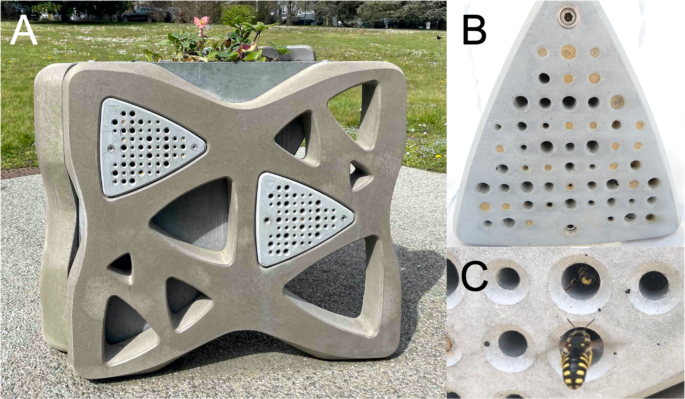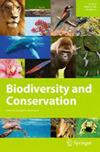评估孔洞筑巢蜜蜂的混凝土巢箱
IF 3
2区 环境科学与生态学
Q1 BIODIVERSITY CONSERVATION
引用次数: 0
摘要
摘要:人工巢箱在生态研究、作物授粉支持和公众宣传等方面的应用越来越广泛。它们的吸引力和独居蜜蜂的殖民化成功取决于它们的设计和位置,包括洞的尺寸、方向、邻近的栖息地和可用的资源。虽然大多数蜂窝箱是由木制材料制成的,但我们在这里评估了多年生混凝土蜂窝箱对孔穴筑巢蜜蜂的适用性。我们对法国11个不同地点的52个定制巢箱进行了为期三年的筑巢调查,总共有2912个直径为6、8、10或12毫米的孔。混凝土巢箱成功地吸引了独居蜜蜂的生殖雌性,并支持幼虫的成功发育,直到新个体的出现。优选的空腔是最小的(6-8 mm),位于离地最低的测试位置(31-47 cm),朝向南。在几乎所有的研究地点,建立在巢箱中的当地蜜蜂种群在连续三个季节稳步增长。在洞穴筑巢的蜜蜂群体大多是由相当常见和通才的物种组成的,但也包括觅食专家。此外,还检出2种寄生蜂。所有的物种都属于巨蝇科。我们进一步讨论了邻近的城市和自然栖息地作为筑巢蜜蜂的潜在来源或汇的影响,以及混凝土巢箱作为城市农业工具的机会,更广泛地说,为新的仿生城市设计提供了恢复城市当地生态系统服务的机会。本文章由计算机程序翻译,如有差异,请以英文原文为准。

Assessing concrete nest boxes for cavity-nesting bees
Abstract Artificial nest boxes for solitary bees and other cavity-nesting Hymenoptera are increasingly used for a variety of purposes, including ecological research, crop pollination support and public outreach. Their attractivity and colonization success by cavity-nesting solitary bees depend on their design and placement, including hole dimensions, orientation and the neighboring habitats and available resources. While most bee nest boxes are made of wooden materials, we assessed here the suitability of perennial, concrete nest boxes for cavity-nesting bees. We carried out a three-year nesting survey of 52 custom-made nest boxes located in 11 different sites throughout France and totaling 2912 available holes of 6, 8, 10 or 12 mm in diameter. Concrete nest boxes successfully attracted reproductive females of solitary bee species and supported successful larval development until the emergence of new individuals. Preferred cavities were the smallest ones (6-8 mm), located at the lowest tested positions above ground (31-47 cm) and oriented southward. Local bee populations established in nest boxes steadily increased throughout the three successive seasons in nearly all study sites. The cavity-nesting bee communities were mostly composed of rather common and generalist species, but also comprised a foraging specialist. Additionally, two cleptoparasitic bee species were detected. All species belonged to the Megachilidae. We further discuss the effects of neighboring urban and natural habitats as potential source or sink of nesting bees, as well as opportunities of concrete nest boxes as tools for urban agriculture and more generally for the new biomimetic urban designs to restore local ecosystem services in cities.
求助全文
通过发布文献求助,成功后即可免费获取论文全文。
去求助
来源期刊

Biodiversity and Conservation
环境科学-环境科学
CiteScore
6.20
自引率
5.90%
发文量
153
审稿时长
9-18 weeks
期刊介绍:
Biodiversity and Conservation is an international journal that publishes articles on all aspects of biological diversity-its description, analysis and conservation, and its controlled rational use by humankind. The scope of Biodiversity and Conservation is wide and multidisciplinary, and embraces all life-forms.
The journal presents research papers, as well as editorials, comments and research notes on biodiversity and conservation, and contributions dealing with the practicalities of conservation management, economic, social and political issues. The journal provides a forum for examining conflicts between sustainable development and human dependence on biodiversity in agriculture, environmental management and biotechnology, and encourages contributions from developing countries to promote broad global perspectives on matters of biodiversity and conservation.
 求助内容:
求助内容: 应助结果提醒方式:
应助结果提醒方式:


